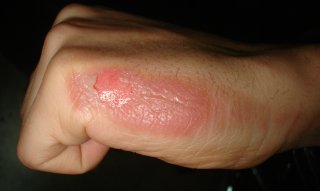Burns
Burns are injuries to the skin or other tissues caused by heat, cold, electricity, chemicals, friction, or ultraviolet radiation. They are classified into four types based on their severity: first-degree, second-degree, third-degree, and fourth-degree burns. The extent of tissue damage varies with the depth and cause of the burn.
Signs and Symptoms
The characteristics of a burn depend on its depth:
- First-degree burns affect the superficial skin layers, appearing red without blisters. Pain typically lasts around three days.
- Second-degree burns extend into some of the underlying skin layers and often have blisters and significant pain. Healing can take up to eight weeks, with possible scarring.
- Third-degree burns involve the entire skin thickness, resulting in a stiff, pain-free area. These burns do not heal on their own.
- Fourth-degree burns extend into deeper tissues such as muscles, tendons, or bones, often leading to loss of the affected part.

Burns around the mouth or nose may suggest airway burns, indicated by shortness of breath, hoarseness, stridor, or wheezing. Itchiness is common during healing, and emotional distress may also occur.
Diagnosis
Burns are diagnosed based on depth, mechanism of injury, extent, and associated injuries. The depth of a burn is usually determined through examination and may require multiple assessments over time. The extent of a burn is measured as a percentage of total body surface area (TBSA) affected, excluding first-degree burns. The Wallace rule of nines and the Lund and Browder chart are common methods used to estimate TBSA.

Treatment
Initial Management
Initial management focuses on airway, breathing, and circulation. If inhalation injury is suspected, early intubation may be necessary. Cooling the burn with cool (not ice) water within 30 minutes can reduce depth and pain. Chemical burns require extensive irrigation. Burn wounds should be cleaned with soap and water, and dead tissue removed. Tetanus prophylaxis is recommended if the patient's immunisation status is uncertain.
Fluid Resuscitation
Fluid resuscitation is very important for burns over 10-20% TBSA in children and over 15% in adults. The Parkland formula guides the volume of intravenous fluids required in the first 24 hours. This formula is based on the patient's TBSA and weight, with half the fluid given in the first 8 hours and the remainder over the next 16 hours.
Wound Care
Wound care involves cleaning, debridement, and dressings. The management of blisters is debated, but small blisters are generally left intact, while large ones may be drained. Topical antibiotics may be used to prevent infection, but silver sulfadiazine is not recommended as it may delay healing.
Medications
Pain management is essential and may involve simple analgesics, opioids, and anxiolytics. Antihistamines, massage, or transcutaneous nerve stimulation may help with itching. Antibiotics are reserved for cases of severe burns or prior to surgery to reduce the risk of infection.
Surgery
Surgical intervention may be necessary for wounds requiring closure with skin grafts or flaps. Early excision and skin grafting are recommended for full-thickness burns. Escharotomies may be needed for circumferential burns to prevent complications with circulation and ventilation.

Complications
Infections are the most common complications, with pneumonia, cellulitis, and urinary tract infections being frequent. Anaemia is common in full-thickness burns over 10% TBSA. Electrical burns may cause compartment syndrome or rhabdomyolysis. Long-term complications include keloids, psychological trauma, and disturbances in body image.

Self-assessment MCQs (single best answer)
Burns are injuries to the skin or other tissues caused by:
Which type of burn affects the superficial skin layers and appears red without blisters?
Which of the following statements is true about third-degree burns?
What is a common method used to estimate the total body surface area (TBSA) affected by burns?
What is the primary focus of initial management for burn injuries?
For burns over what percentage of TBSA is fluid resuscitation very important in adults?
Which of the following is NOT recommended for use in preventing infection in burn wounds?
What surgical intervention may be necessary for full-thickness burns?
Which type of burn extends into muscles, tendons, or bones?
Which of the following is a common complication of burn injuries?
Dentaljuce
Dentaljuce provides Enhanced Continuing Professional Development (CPD) with GDC-approved Certificates for dental professionals worldwide.
Founded in 2009 by the award-winning Masters team from the School of Dentistry at the University of Birmingham, Dentaljuce has established itself as the leading platform for online CPD.
With over 100 high-quality online courses available for a single annual membership fee, Dentaljuce offers comprehensive e-learning designed for busy dental professionals.
The courses cover a complete range of topics, from clinical skills to patient communication, and are suitable for dentists, nurses, hygienists, therapists, students, and practice managers.
Dentaljuce features Dr. Aiden, a dentally trained AI-powered personal tutor available 24/7 to assist with queries and provide guidance through complex topics, enhancing the learning experience.
Check out our range of courses, or sign up now!


